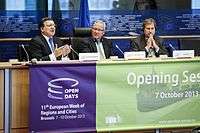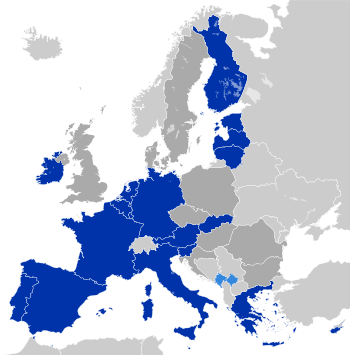European Committee of the Regions
 | |
| Formation | 1994 |
|---|---|
| Type | EU body |
| Purpose | Consultative to the EU institutions; subsidiarity monitoring — can approach the Court of Justice of the European Union with regard to the application of subsidiarity principle |
| Location | |
| Coordinates | 50°50′26″N 4°22′38″E / 50.84056°N 4.37722°ECoordinates: 50°50′26″N 4°22′38″E / 50.84056°N 4.37722°E |
Membership | 350 |
President | Markku Markkula (Finland, EPP) |
| Website |
www |
| European Union |
 This article is part of a series on the |
Policies and issues
|
The European Committee of the Regions (CoR) is the European Union's (EU) assembly of local and regional representatives that provides sub-national authorities (i.e. regions, counties, provinces, municipalities and cities) with a direct voice within the EU's institutional framework.
Established in 1994, the CoR was set up to address two main issues. First, about three quarters of EU legislation is implemented at local or regional level, so local and regional representatives needed to have a say in the development of new EU laws. Second, there were concerns about a widening gap between the public and the process of European integration; involving the elected level of government closest to the citizens was one way of closing the gap.[1]
History
Within the European Union local and regional authorities have lobbied for an increased say in EU affairs. This resulted in the creation by the Maastricht Treaty of the European Committee of the Regions, and provision for member states to be represented in the Council of the EU by ministers from their regional governments.[2]
Principles
There are three main principles at the heart of the Committee's work:[3]
- Subsidiarity
- This principle, enshrined into the Treaties at the same time as the creation of the CoR, means that decisions within the European Union should be taken at the closest practical level to the citizen. The European Union, therefore, should not take on tasks which are better suited to national, regional or local administrations.[4]
- Proximity
- All levels of government should aim to be 'close to the citizens', in particular by organising their work in a transparent fashion, so people know who is in charge of what and how to make their views heard.
- Partnership
- Sound European governance means European, national, regional and local government working together – all four are indispensable and should be involved throughout a "multi-level governance" decision making process.
Scope
The Treaties oblige the European Commission and the Council of the European Union to consult the Committee of the Regions whenever new proposals are made in areas that have repercussions at regional or local level. Outside these areas, the Commission, Council and European Parliament have the option to consult the CoR on issues if they see important regional or local implications to a proposal. The CoR can also draw up an opinion on its own initiative, which enables it to put issues on the EU agenda.
The CoR has gained the right (privileged status) to approach the European Court of Justice now that the Treaty of Lisbon has entered into force following ratification by all EU Member States (Article 8, Protocol (No. 2) on the Application of the Principles of Subsidiarity and Proportionality.[5]
Composition
The CoR has 350 full members and the same number of alternate members.[6] The number from each EU country roughly reflecting the size of its population. Its members are locally and regionally elected representatives including mayors, regional presidents and councillors. The numbers per country are as follows:
| State | Members | State | Members | State | Members |
|---|---|---|---|---|---|
| |
24 | |
12 | |
9 |
| |
24 | |
12 | |
9 |
| |
24 | |
12 | |
9 |
| |
24 | |
12 | |
7 |
| |
21 | |
12 | |
7 |
| |
21 | |
12 | |
6 |
| |
15 | |
9 | |
5 |
| |
12 | |
9 | |
5 |
| |
12 | |
9 | |
5 |
| |
12 | ||||
| Total | 350 | ||||
Internal structure


President
Elected for a two-and-a-half-year term at the plenary assembly, the President guides the Committee's work, chairs plenary sessions and is the CoR's official representative. Markku Markkula (Finland / European People's Party), member of the Espoo City Council, is the current President elected on 12 February 2015.
List of Presidents
| CoR President | Presidency | Nationality | European political group | |
|---|---|---|---|---|
| Markku Markkula, Espoo | 2015–present | |
European People's Party | |
| Michel Lebrun, Wallonia | 2014–2015 | |
European People's Party | |
| Ramón Luis Valcárcel, Murcia | 2012–2014 | |
European People's Party | |
| Mercedes Bresso, Piedmont | 2010–2012 | |
Party of European Socialists | |
| Luc van den Brande, Flanders | 2008–2010 | |
European People's Party | |
| Michel Delebarre, Dunkirk, Nord-Pas-de-Calais | 2006–2008 | |
Party of European Socialists | |
| Peter Straub, Baden-Württemberg | 2004–2006 | |
European People's Party | |
| Sir Albert Bore, Birmingham | 2002–2004 | |
Party of European Socialists | |
| Jos Chabert, Brussels-Capital Region | 2000–2002 | |
European People's Party | |
| Manfred Dammeyer, North Rhine-Westphalia | 1998–2000 | |
Party of European Socialists | |
| Pasqual Maragall, Barcelona, Catalonia | 1996–1998 | |
Party of European Socialists | |
| Jacques Blanc, Languedoc-Roussillon | 1994–1996 | |
European People's Party | |
First Vice-President
The First Vice-President is also elected by the plenary assembly for two-and-a-half years and represents the President in the latter's absence. Karl-Heinz Lambertz (Belgium / Progressive Alliance of Socialists and Democrats, PES), President of the Parliament of the German-speaking Community of Belgium, was elected First Vice-President of the European Committee of the Regions on 12 February 2015.
Bureau
The Bureau is the executive body of the CoR. It comprises 63 members: the President, First Vice-President, 28 vice-presidents (one per Member State), the Presidents of the CoR political groups and 28 other members from the national delegations, enabling it to reflect national and political balances. The Bureau generally meets seven or eight times a year to draw up the CoR’s policy programme and instructs the administration on the implementation of its decisions.
Plenary assembly
The members of the CoR meet in plenary session in Brussels six times a year, to discuss and adopt opinions, reports and resolutions.
CoR commissions
The CoR structures its work by means of six thematic commissions, which specialise in topical areas:
- CIVEX: citizenship, governance, institutional and external affairs
- COTER: territorial cohesion policy;
- ECON: economic policy;
- ENVE: environment, climate change and energy;
- NAT: natural resources and agriculture;
- SEDEC: social policy, employment, education, culture and research.
They prepare draft opinions and hold conferences and seminars focused on their areas of competence. Each commission has approximately 100 members (each member can be part of two commissions) and is supported by a secretariat within the administration. A special Commission for Financial and Administrative Affairs (CFAA) is also established to assist the CoR Bureau.
Political groups
The CoR has five political groups: the Progressive Alliance of Socialists and Democrats (PES), the European People’s Party (EPP), the Alliance of Liberals and Democrats for Europe (ALDE), the European Alliance (EA) and the European Conservatives and Reformists (ECR). The members of each political group meet before major meetings to adopt common positions.
Conference of Presidents
The CoR President, First Vice-President, Presidents of the political groups and the Secretary General gather within a Conference of Presidents before each plenary session and other important meetings, with the aim of reaching a political consensus on strategic questions.
National delegations
The CoR also comprises 28 national delegations.[7] Members meet in their national delegations before plenary sessions and other events to discuss common positions.
Secretary-General
The Secretary-General is appointed for five years by the Bureau. As head of the CoR administration, the Secretary-General must not hold a political mandate. He is responsible for implementing President's and Bureau decisions and the smooth running of the CoR administration. Jiří Buriánek is the CoRs' Secretary-General since 1 September 2014.
Secretariat-General
The Secretariat-General consists of five directorates: Members and Plenaries; Legislative Work 1; Legislative Work 2; Communication; Human Resources and Finance. The Logistics and Translations Directorates are jointly managed with the European Economic and Social Committee. The total number of CoR staff in 2015 was 527.
Budget
Compared to the substantially increased role of the CoR in the global EU framework, as indicated by the Lisbon Treaty, the CoR remains a lean and very efficient organization, which makes it the third smallest EU institution in terms of budgetary needs. The CoR's 2013 budget (86,5 mil. EUR) represents only 0.06% of the total EU budget. Its 2014 budget (90,2 mil. EUR) breakdown according to purpose of expenditure is as follows: 39,7% - Consultative Works (35,8 mil. EUR); 30,3% - Translation, Interpretation and Print (27,2 mil. EUR); 30% - Administration and Functioning (27 mil. EUR). The CoR's 2015 budget was 89,2 mil. EUR. Although all CoR expenditure formally falls under Heading 5 (Administrative expenditure) of the EU Budget, as is the case for the European Parliament budget, a substantial part of its budget relates to non-administrative expenditure. Most obvious examples are all CoR expenses related to its Members and their political activities.
Work


Opinions
The European Commission, Council of Ministers and European Parliament consult the CoR when drawing up legislative texts (directives, regulations, etc.) on areas affecting local and regional authorities. The draft texts are forwarded to the relevant CoR commission. A rapporteur is then appointed to draw up the Committee's opinion. This draft opinion must be adopted by the CoR commission before being discussed at the plenary session. Once it has been approved in plenary, the official opinion is sent to all the European institutions and published in the Official Journal of the European Union.
Resolutions
Resolutions enable the Committee to express its view on important and topical issues. The CoR's political groups or 32 CoR members can draw up resolutions.
Studies and other publications
The CoR produces studies on various aspects of the local and regional dimension of the EU (education, transport, social issues, enlargement, etc.). They are drawn up with the help of outside experts. The CoR also produces publications for both the general public and for regional and local players, aimed at explaining its activities and outlining current political developments.
Events
As a meeting place for regions and cities, the CoR organises conferences, seminars and exhibitions in cooperation with local and regional partners and other EU institutions. Once a year, during the European Week of Regions and Cities (OPEN DAYS), the CoR welcomes to its headquarters thousands of participants who take part in lively discussions or seek partners to collaborate on joint projects.
Key dates
- 1992 — Maastricht Treaty
- EU leaders decide to set up the Committee of the Regions (CoR) as a consultative assembly which will provide regions and cities with a voice in the EU decision-making process and act as a direct link between Brussels and the citizens. The Treaty makes it mandatory for the European Commission and the Council of Ministers to consult the CoR on key areas of regional concern. CoR members are to be nominated by the governments of Member States and will serve for four years. In March 1994 the CoR holds its first plenary session in Brussels.
- 1995 — EU enlargement
- The CoR's membership increases from 189 to 222, following the accession of Austria, Finland and Sweden.
- 1997 — Amsterdam Treaty
- Extends the CoR's remit to cover around two thirds of the EU's legislative proposals. The Treaty also makes it possible for the Committee to be consulted by the European Parliament.
- 2001 — Nice Treaty
- Underlines the democratic legitimacy of the CoR by requiring that its members are elected or politically accountable to an elected regional or local assembly. Caps the number of members at 350.
- 2002–03 — Convention on the Future of the EU
- CoR members take part in the convention responsible for drafting an EU constitution. The text expressly recognises the role and powers of local and regional government; it also gives the CoR the right to go to the Court of Justice of the European Communities to challenge EU laws which do not comply with the principle of subsidiarity.
- May 2004 — EU enlargement
- Number of CoR members increases from 222 to 317, following the accession of 10 new Member States.
- February 2006 — New term of office
- The CoR starts a new four-year term. Its political priorities include boosting the role of local and regional authorities in line with the Lisbon Strategy for Jobs and Growth, strengthening cohesion and solidarity, and spearheading the ‘Communicating Europe – Going local’ campaign to bring the EU closer to its citizens.
- January 2007 — EU enlargement
- With the accession of Bulgaria and Romania, the number of CoR members rises from 317 to 344.
- December 2007 — Lisbon Treaty
- The Lisbon Treaty confirms the CoR's right to appeal to the Court of Justice of the European Communities to safeguard its prerogatives and the subsidiarity principle – a right already recognised by the Convention on the Future of the EU. This new entitlement will strengthen the CoR's political role, by enabling it to act more effectively on the EU stage for the benefit of regional and local authorities. The Lisbon Treaty extends the term of office of CoR members from four to five years.
July 2013 — EU enlargement
- Number of CoR members increases from 344 to 353, following the accession of Croatia (CoR members later decreased to 350).
See also
References
- ↑ "Summaries of EU legislation". Europa. Retrieved 12 June 2013.
- ↑ Wagstaff, Peter (1999). Regionalism in the European Union. United Kingdom: Intellect Books. p. 185. ISBN 1-84150-001-1.
- ↑ "Key Facts". Committee of the Regions. Retrieved 12 June 2013.
- ↑ "Summaries of EU legislation". Europa. Retrieved 12 June 2013.
- ↑ http://eur-lex.europa.eu/LexUriServ/LexUriServ.do?uri=OJ:C:2007:306:0150:0152:EN:PDF
- ↑ Delegation of the European Union to Croatia. "Croatian Delegation in EU Committee of the Regions". Retrieved 12 June 2013.
- ↑ "CoR — National delegations". Europa. Retrieved 20 May 2015.
External links
- Committee of the Regions
- Europe in my Region
- List of Members
- The committee of the Regions : European Navigator
- Subsidiarity Monitoring Network of the Committee of the Regions
- Atlas of Decentralised cooperation for Development, a website dedicated to decentralised cooperation developed joinly by the Committee of the Regions and the European Commission
- Group of the European People's party in the Committee of the Regions
- Group of the Party of European Socialists in the Committee of the Regions
- Group of the Alliance of Liberals and Democrats for Europe in the Committee of the Regions
- Group of the European Alliance in the Committee of the Regions
- Group of the European Conservatives and Reformists in the Committee of the Regions

